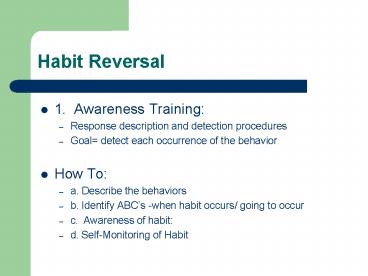Habit Reversal PowerPoint PPT Presentation
1 / 18
Title: Habit Reversal
1
Habit Reversal
- 1. Awareness Training
- Response description and detection procedures
- Goal detect each occurrence of the behavior
- How To
- a. Describe the behaviors
- b. Identify ABCs -when habit occurs/ going to
occur - c. Awareness of habit
- d. Self-Monitoring of Habit
2
Habit Reversal
- 2. Competing response training
- Client performs a behavior _______________ with
the habit behavior - Client PRACTICES competing response and imagines
situations in which will use competing response
3
Habit Reversal
- 3. Social support
- Children Increase time-in and positive attention
when not pulling
4
Why does habit reversal work?
- Increase in awareness of the habit behavior
- Competing response serves as a punisher
- Competing response replaces the habit behavior
- Combination of reasons
5
Other interventions depending on hair pulling
behaviors
- 2. Relaxation Training
- 3. Cognitive-Behavior Therapy
- 4. Increase Coping Skills
6
Fear and Anxiety Reduction Procedures
- Behavior Modification
7
Anxiety Disorders (extra info)
- Separation Anxiety Disorder
- Social Phobia (Social Anxiety Disorder)
- Specific Phobia
- Generalized Anxiety Disorder (GAD)
- Panic Disorder w/o Agoraphobia
- Agoraphobia w/o panic
- Obsessive-compulsive Disorder
8
Fears are typical in children
- Developmental progression to types of fears
- preschool children
- school-age children
- adolescents
9
Selected Interventions for Fear/ Anxiety Reduction
- Relaxation Training
- Systematic Desensitization
- relaxation training
- development of anxiety hierarchy
- Desensitization
- Exposure Based Strategies
- Modeling
- Cognitive Strategies and Self-Management
10
Relaxation Training
- Three different types of relaxation training
procedures - Progressive muscle relaxation
- Diaphragmatic breathing
- Attention-focusing exercises (guided imagery)
- Measure anxiety
11
Progressive muscle relaxation
- Two Steps
- 1. Deliberately/ Systematically
- 2. Release
12
Progressive muscle relaxation
- Person notices.
- the difference between
- decreased level of tension in the muscle group,
and then - Relaxed
- PracticeEventually, cue relaxation
13
Evaluation of Progressive Muscle
Relaxation Each of the statements below talks
about if you felt you were able to do each of the
relaxations for each muscle group. Circle the
response that is how you think or feel right
now. Scale 1 Strongly Agree 2 Agree 3
Dont know 4 Disagree 5 Strongly
Disagree 1. I was able to tighten and relax my
forehead 1 2 3 4 5 2. I was able to tighten
and relax my eyes 1 2 3 4 5 3. I was able to
tighten and relax my nose 1 2 3 4 5 4. I was
able to tighten and relax my smile 1 2 3 4 5 5.
I was able to tighten and relax my
tongue 1 2 3 4 5 6. I was able to tighten and
relax my jaw 1 2 3 4 5 7. I was able to
tighten and relax my lips 1 2 3 4 5 8. I was
able to tighten and relax my neck 1 2 3 4 5 9.
I was able to tighten and relax my
arms 1 2 3 4 5 10. I was able to tighten and
relax my legs 1 2 3 4 5 11. I found the
exercise to be helpful in 1 2 3 4 5
managing my stress 16. I found I was better
able to identify how 1 2 3 4 5 my body
reacts to stress
14
Diaphragmatic breathing
- Teach to breath in a more relaxed breathing
pattern - Place hand on the abdomen just below
- Inhale slowly for ______ seconds and exhale
slowly for _____ seconds - Focus on
15
Relaxation for Test Anxiety Western New England
College, Psychology Department Audio File on my
webpage
16
Attention-focusing exercises
- Produces relaxation by directing attention to a
neutral or pleasant stimulus (and away from
) - What are some strategies you use?
- Incorporate multiple
17
Systematic Desensitization
- Step 1 Relaxation Training
- Step 2 Develop hierarchy of fear/ anxiety
stimuli - List
- Use fear rating scale
18
Desensitization
- Step 3 Desensitization
- Systematically pair ____________ with each
scene/ step of the anxiety hierarchy - Imagine scene while maintaining
- In-Vivo Desensitization
- Gradually expose
- Practice!

